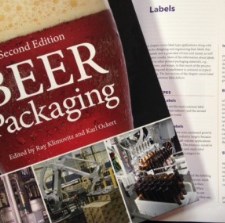Turn the Page – Beer Packaging Second Edition
May 16, 2014
Calling all beer connoisseurs – read any good books likely? And no, browsing Twitter or glancing through the local newspaper doesn’t count. I’m talking mind-boggling, page-turning goodness. Anything come to mind?
Well if you’re looking for a suggestion, we know just the thing to crack open (besides a beer, that is). Touted as ‘The Most Comprehensive Book on Beer Packaging Ever Written,’ it’s filled with all the dirty details on the beer packaging process. Beer Packaging Second Edition, edited by Ray Klimovitz and Karl Ockert, is the latest Master Brewers Association of the Americas masterpiece.
From filtration to the packaging line, this book covers 29 chapters of beer packaging tips straight from the experts. But we have to admit, our favorite Chapter is #18 – Labels, written by our very own Mark Glendenning. This chapter covers all the label topics worth knowing (and implementing, of course).
Interested in learning the differences amongst beer label types? We’ve got it covered. Wondering how to design your label with cost and runnability in mind? Consider yourself informed. Sick and tired of wrapping your mind around a particular beer label defect that has you ready to start smashing bottles? Calm down, my friend. We’ll show you how it can be avoided. Here are a few snippets just for our blog audience:
- Label Types: Cut-and-stack labels get their name from how they are cut and packaged into stacks of labels. It is the most common label type used, especially in beer packaging.
- Label Design: Drawdowns are a sample of the actual ink laid down on the actual substrate that the labels will be printed on to give an accurate representation of what the color will look like once printed.
- Label Production: Ink carryover from one plate to the next is avoided by drying the ink from one print station to the next. Small dryers are located on the machines between each printing plate.
- Label Finishing: An operator takes stacks of sheets and places them onto a jogging machine. This machine basically shakes the stack of press sheets to remove all of the air from between the sheets, which allows the stack to be squared up so that precise cuts can be made later.
We don’t want to give it all away, so you’ll have to order the book if you care to get more of the juicy details. Swing on over to the Master Brewers Association of the Americas store to order your copy today.



